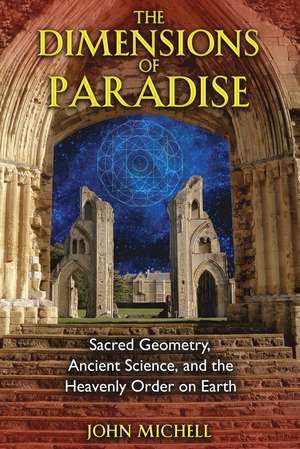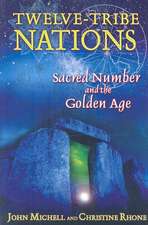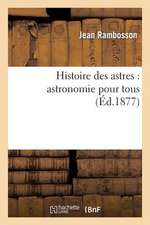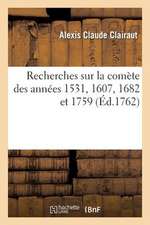The Dimensions of Paradise: Sacred Geometry, Ancient Science, and the Heavenly Order on Earth
Autor John Michellen Limba Engleză Paperback – 7 ian 2008
Preț: 76.65 lei
Preț vechi: 102.20 lei
-25% Nou
Puncte Express: 115
Preț estimativ în valută:
14.67€ • 15.35$ • 12.14£
14.67€ • 15.35$ • 12.14£
Carte disponibilă
Livrare economică 21 martie-02 aprilie
Preluare comenzi: 021 569.72.76
Specificații
ISBN-13: 9781594771989
ISBN-10: 1594771987
Pagini: 256
Ilustrații: 70 b&w illustrations
Dimensiuni: 152 x 229 x 15 mm
Greutate: 0.34 kg
Ediția:3rd Edition, New Edition
Editura: Inner Traditions/Bear & Company
Colecția Inner Traditions
Locul publicării:United States
ISBN-10: 1594771987
Pagini: 256
Ilustrații: 70 b&w illustrations
Dimensiuni: 152 x 229 x 15 mm
Greutate: 0.34 kg
Ediția:3rd Edition, New Edition
Editura: Inner Traditions/Bear & Company
Colecția Inner Traditions
Locul publicării:United States
Notă biografică
John Michell, educated at Eton and Cambridge, is the pioneer researcher and specialist in the field of ancient, traditional science. He is the author of more than twenty-five books that have profoundly influenced modern thinking, including The New View Over Atlantis, Secrets of the Stones, and The Temple of Jerusalem: A Revelation.
Extras
from Chapter 5
SYMBOLIC NUMBER
The first characteristic of the Heavenly Jerusalem is completeness. As a symbol of the entire universe it should display in its dimensions the number representing every god, power, or tendency in nature. Some of the principal numbers in the scheme have here been identified; among them are 3168, 1080, 1224, and 1746, and there is reference also to 864 and 666. All these numbers were applied by gematria to important names and phrases in the sacred texts of early Christianity, which provides clues to their symbolism, and further inferences are derived from their astronomical and other associations. They exemplify the manifold significance that the ancients discovered in certain numbers, which caused them to make use of those numbers for codifying their knowledge of the world.
1224, the number of Paradise,
and the 153 fishes in the net
The total width of the New Jerusalem diagram is equal to the diameter of the earth plus two diameters of the moon, or 12,240 miles. Thus the number 1224 refers to the cosmological city, image of God’s creation. This interpretation accords well with the gematria of 1224.
1224 = ὁ κυριος ὁ θεος, the Lord God
= κτισις θεου, God’s creation
= κυκλος θεου, divine circle
= ἡ ϕυτεια, the plantation (Matthew 5:13), an early Christian synonym of paradise
Similar meanings are found in the gematria of the numbers on either side of 1224.
1223 = ἡ ὁδος παραδεισου, the way of paradise
1225 = Ὁ παραδεισος θεου, God’s paradise (Revelation 2:7)
= ἐγω εἰμι ἡ ὁδος, I am the way ( John 14:6)
= ἀρχηγετης, founder of the city
= ἡ δικαιοσυνη θεου, the righteousness of God (Romans 3:22)
= ἑν ὁλον ὁλων, the entirety of creation (literally, One Whole of Wholes), Plato’s phrase in Timaeus for the unique sphere of the cosmos embracing all its parts.
Several of the incidents and parables in the New Testament story of Jesus are known to have been adapted from earlier writings, and some of these have hidden meanings that the Christian gnostics interpreted using the same cabalistic methods that the Jews apply to the exegesis of their own scriptures. Most obviously numerical is the tale of the miraculous catch of 153 fishes, which occurs in the last chapter of St. John’s Gospel. Why there should have been exactly 153 fishes in the net that the Apostles cast into the Sea of Tiberias is a question that has puzzled commentators from early Christian times. A clue that previous writers have noticed is that two of the key words in the story, ἰχθυες, fishes, and το δικτυον, the net, each have the value by gematria of 1224, and 1224 is 8 times 153.
Following up this clue we are led on to reconstruct the figure of sacred geometry that must originally have accompanied the story of the 153 fishes. It develops in three stages, reflecting the order of events in John 21.
After the Crucifixion, Simon Peter went fishing from a boat in the Sea of Tiberias, taking with him six of the other disciples. They fished all night but caught nothing.
In the morning they saw the risen Jesus on the shore but failed to recognize him. He called out that they should cast their net on the right side of the boat. Having done so, they were unable to draw it out for the multitude of fishes in it.
John then recognized Jesus and told Simon Peter, who put on his fisher’s coat and jumped into the sea. The other disciples followed him in the boat to the shore, which was about 200 cubits away, dragging the net with the fishes. When Simon Peter drew it to land it was found to be “full of great fishes, an hundred and fifty and three: and for all there were so many, yet was not the net broken.”
The number of Σιμων ὁ Πετρος, Simon Peter, is 1925, so Peter can be represented by a circle with circumference 1925 and diameter 612½ or 612. This is appropriate because 612 is the number of ὁ ποιμην ἀγαθος, the Good Shepherd, and that is the title which Simon Peter inherits when, following the incident of the 153 fishes, he is told three times by Jesus, “Feed my sheep.”
Six more circles of the same dimensions are drawn for the six other disciples, and the seven are packed together in the most economical way and placed inside the circular boat, like the coracle of the Celtic saints, the diameter of which is 1224.
The disciples are told to cast their net on the right side of the boat. This is done geometrically by placing the compass point on the circumference of the circular boat and drawing an arc of another circle with the same radius, containing a Vesica Piscis (vessel of the fish). The rhombus within it is divided up into sixteen smaller diamond shapes. Its width being 612, each of its sixteen divisions has a width of 153. They represent sixteen small fishes making up a greater seventeenth, and here again the number 153 is brought out, for 153 is the sum of the numbers from 1 to 17. The measure around the four sides of the greater rhombus-fish is 2448 or 1224 1224 or το δικτυον, the net, plus ἰχθυες, fishes. Thus the net full of 153 fishes is illustrated in number and geometry.
It is a traditional practice among teachers of esoteric philosophy to set forth their doctrines in the guise of simple parables, which amuse children, enrich popular mythology, and, for those who understand the science of interpreting them, illustrate various cosmological processes. The themes that are adopted by hagiographers and composers of sacred legends are those that occur spontaneously in different times and cultures and can therefore be called archetypal. Thus the founders of Christianity took certain episodes in universal folklore and made Jesus their central figure. In the tale of the 153 fishes he plays the part of the shamanic man of miracles whose traditional functions include bringing good luck to hunters or fishermen. By interpolation of names and numbers this story was made to reflect the construction of a geometric diagram with cosmological significance, by reference to which the gnostic masters were able to demonstrate to initiates the basic truth behind the Christian legend.
SYMBOLIC NUMBER
The first characteristic of the Heavenly Jerusalem is completeness. As a symbol of the entire universe it should display in its dimensions the number representing every god, power, or tendency in nature. Some of the principal numbers in the scheme have here been identified; among them are 3168, 1080, 1224, and 1746, and there is reference also to 864 and 666. All these numbers were applied by gematria to important names and phrases in the sacred texts of early Christianity, which provides clues to their symbolism, and further inferences are derived from their astronomical and other associations. They exemplify the manifold significance that the ancients discovered in certain numbers, which caused them to make use of those numbers for codifying their knowledge of the world.
1224, the number of Paradise,
and the 153 fishes in the net
The total width of the New Jerusalem diagram is equal to the diameter of the earth plus two diameters of the moon, or 12,240 miles. Thus the number 1224 refers to the cosmological city, image of God’s creation. This interpretation accords well with the gematria of 1224.
1224 = ὁ κυριος ὁ θεος, the Lord God
= κτισις θεου, God’s creation
= κυκλος θεου, divine circle
= ἡ ϕυτεια, the plantation (Matthew 5:13), an early Christian synonym of paradise
Similar meanings are found in the gematria of the numbers on either side of 1224.
1223 = ἡ ὁδος παραδεισου, the way of paradise
1225 = Ὁ παραδεισος θεου, God’s paradise (Revelation 2:7)
= ἐγω εἰμι ἡ ὁδος, I am the way ( John 14:6)
= ἀρχηγετης, founder of the city
= ἡ δικαιοσυνη θεου, the righteousness of God (Romans 3:22)
= ἑν ὁλον ὁλων, the entirety of creation (literally, One Whole of Wholes), Plato’s phrase in Timaeus for the unique sphere of the cosmos embracing all its parts.
Several of the incidents and parables in the New Testament story of Jesus are known to have been adapted from earlier writings, and some of these have hidden meanings that the Christian gnostics interpreted using the same cabalistic methods that the Jews apply to the exegesis of their own scriptures. Most obviously numerical is the tale of the miraculous catch of 153 fishes, which occurs in the last chapter of St. John’s Gospel. Why there should have been exactly 153 fishes in the net that the Apostles cast into the Sea of Tiberias is a question that has puzzled commentators from early Christian times. A clue that previous writers have noticed is that two of the key words in the story, ἰχθυες, fishes, and το δικτυον, the net, each have the value by gematria of 1224, and 1224 is 8 times 153.
Following up this clue we are led on to reconstruct the figure of sacred geometry that must originally have accompanied the story of the 153 fishes. It develops in three stages, reflecting the order of events in John 21.
After the Crucifixion, Simon Peter went fishing from a boat in the Sea of Tiberias, taking with him six of the other disciples. They fished all night but caught nothing.
In the morning they saw the risen Jesus on the shore but failed to recognize him. He called out that they should cast their net on the right side of the boat. Having done so, they were unable to draw it out for the multitude of fishes in it.
John then recognized Jesus and told Simon Peter, who put on his fisher’s coat and jumped into the sea. The other disciples followed him in the boat to the shore, which was about 200 cubits away, dragging the net with the fishes. When Simon Peter drew it to land it was found to be “full of great fishes, an hundred and fifty and three: and for all there were so many, yet was not the net broken.”
The number of Σιμων ὁ Πετρος, Simon Peter, is 1925, so Peter can be represented by a circle with circumference 1925 and diameter 612½ or 612. This is appropriate because 612 is the number of ὁ ποιμην ἀγαθος, the Good Shepherd, and that is the title which Simon Peter inherits when, following the incident of the 153 fishes, he is told three times by Jesus, “Feed my sheep.”
Six more circles of the same dimensions are drawn for the six other disciples, and the seven are packed together in the most economical way and placed inside the circular boat, like the coracle of the Celtic saints, the diameter of which is 1224.
The disciples are told to cast their net on the right side of the boat. This is done geometrically by placing the compass point on the circumference of the circular boat and drawing an arc of another circle with the same radius, containing a Vesica Piscis (vessel of the fish). The rhombus within it is divided up into sixteen smaller diamond shapes. Its width being 612, each of its sixteen divisions has a width of 153. They represent sixteen small fishes making up a greater seventeenth, and here again the number 153 is brought out, for 153 is the sum of the numbers from 1 to 17. The measure around the four sides of the greater rhombus-fish is 2448 or 1224 1224 or το δικτυον, the net, plus ἰχθυες, fishes. Thus the net full of 153 fishes is illustrated in number and geometry.
It is a traditional practice among teachers of esoteric philosophy to set forth their doctrines in the guise of simple parables, which amuse children, enrich popular mythology, and, for those who understand the science of interpreting them, illustrate various cosmological processes. The themes that are adopted by hagiographers and composers of sacred legends are those that occur spontaneously in different times and cultures and can therefore be called archetypal. Thus the founders of Christianity took certain episodes in universal folklore and made Jesus their central figure. In the tale of the 153 fishes he plays the part of the shamanic man of miracles whose traditional functions include bringing good luck to hunters or fishermen. By interpolation of names and numbers this story was made to reflect the construction of a geometric diagram with cosmological significance, by reference to which the gnostic masters were able to demonstrate to initiates the basic truth behind the Christian legend.
Cuprins
Introduction
IN QUEST OF THE CANON
1 THE HEAVENLY CITY AS ETERNAL STANDARD
The Cosmic Temple • The New Jerusalem • The Twelve Hides of Glastonbury • The New Jerusalem in Stonehenge • The Pattern in the Heavens • Contructing the New Jerusalem • Measuring the Courts of the City
2 NUMBER IN SACRED SCIENCE
The Numbers of the Canon • Gematria: The Names and Numbers of God • Symbolic or Sacred Geometry • Sacred Geometry in Dürer’s Melencolia • Music and Proportion • A Circle of Perpetual Choirs
3 NUMBER AND MEASURE
Lengths of Ancient Units of Measure • Summary of the Earth’s Dimensions • The Priority of the Foot • Astronomy
4 THE CITIES OF PLATO
The 5,040 Citizens of Magnesia • From Circle to Square: The City Brought to Earth • Plato’s Secrecy • Atlantis • The Measures of Atlantis • The Problem of the Plain • Why Atlantis Fell • Plato’s Cosmos and the Wanderings of the Soul • The Music of the Heavenly Wheels • The Numerical Creation Myth of Timaeus • The Harmonic Composition of the World Soul • The Number of the Soul
5 SYMBOLIC NUMBER
864, the Foundation Number • 3,168, the Perimeter of the New Jerusalem • 1,224, the Number of Paradise, and the 153 Fishes in the Net • 1,080, the Lunar Number • 666, the Solar Number and the Number of the Beast • 1,746, the Number of Fusion • Sacred Names from the Dimensions of the New Jerusalem
6 THE ANCIENT AND FUTURE COSMOLOGY
Heavenly Jerusalem, Its Invocation and Modern Function
Index of Names
Index of Numbers
Recenzii
“John Michell’s The Dimensions of Paradise is inarguably among the most important Gnostic transmissions of recent generations. With his candid, uncomplicated style, John has made widely available the visions, the laws, and the numbers held within pure geometry and which integrate earth and sky, movement and form, cosmos and mankind.”
“John Michell has produced one of the primary texts for understanding the number system that encoded the prehistoric world view. He reveals how sacred geometry, myth, gematria, and the structure of numbers created a big picture lost soon after Plato, a knowledge replaced by derivative religious and materialistic ideas. The Dimensions of Paradise is an essential key to comprehending monuments such as the Great Pyramid and Stonehenge, but it also provides an initiatory journey into the ancient mind itself.”
"As usual, this is a dense, yet inspiring, read and one that has some practical nuggets in it for those who are looking for a kind of three-dimensional sacred geometry they can apply to daily life."
" . . . a top pick for New Age libraries interested in sacred geometry."
"A must for anyone looking for the science hidden within the matrix of life."
“. . . most intriguing of books. Recommended.”
“John Michell has produced one of the primary texts for understanding the number system that encoded the prehistoric world view. He reveals how sacred geometry, myth, gematria, and the structure of numbers created a big picture lost soon after Plato, a knowledge replaced by derivative religious and materialistic ideas. The Dimensions of Paradise is an essential key to comprehending monuments such as the Great Pyramid and Stonehenge, but it also provides an initiatory journey into the ancient mind itself.”
"As usual, this is a dense, yet inspiring, read and one that has some practical nuggets in it for those who are looking for a kind of three-dimensional sacred geometry they can apply to daily life."
" . . . a top pick for New Age libraries interested in sacred geometry."
"A must for anyone looking for the science hidden within the matrix of life."
“. . . most intriguing of books. Recommended.”
Descriere
An in-depth look at the role of number as a bridge between Heaven and Earth.
























